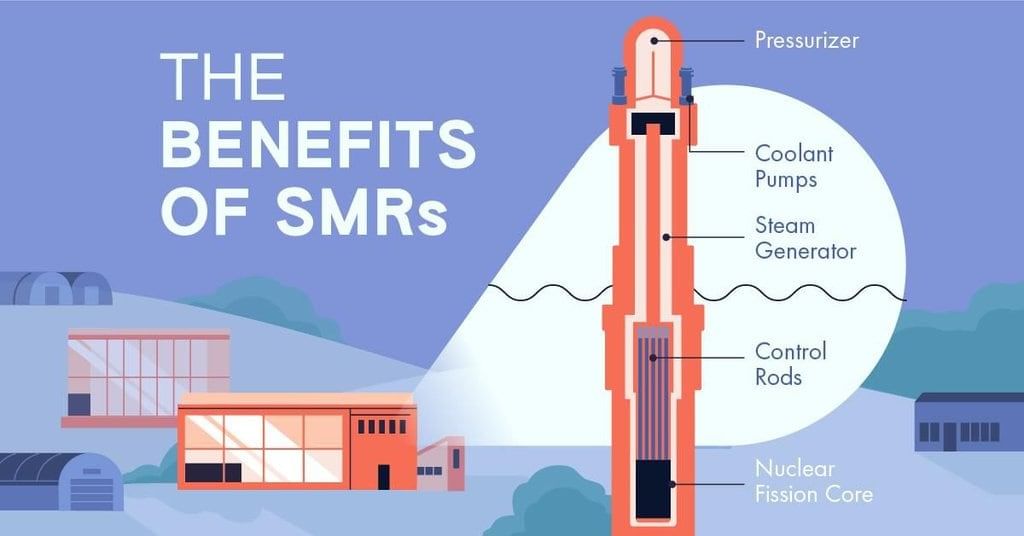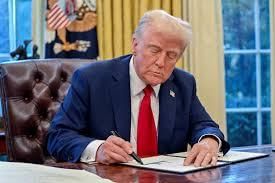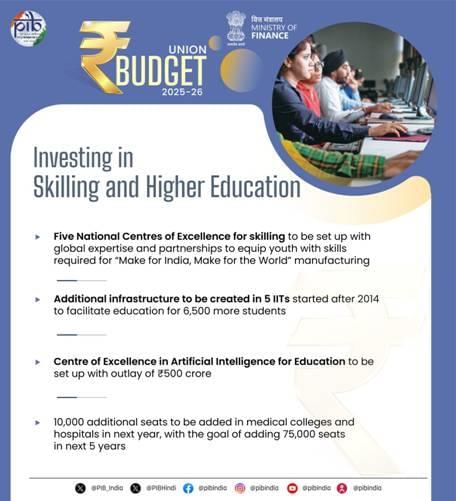UPSC Daily Current Affairs: 3rd February 2025 | Current Affairs & Hindu Analysis: Daily, Weekly & Monthly PDF Download
GS3/Science and Technology
Small Modular Reactors (SMRs)
Source: The Hindu
 Why in News?
Why in News?
The Finance Minister has recently announced a substantial investment of ₹20,000 crore towards a 'Nuclear Energy Mission', aimed at the development of indigenous Small Modular Reactors (SMRs).
- SMRs are defined as small nuclear reactors with a maximum output of 300 Megawatts electric (MWe).
- They can produce approximately 7.2 million kWh per day, significantly less than large nuclear power plants, which exceed 1,000 MWe and generate 24 million kWh per day.
- SMRs offer the potential for a large amount of low-carbon electricity.
Additional Details
- Physical Characteristics: SMRs are much smaller than conventional nuclear power reactors, allowing for factory assembly and transportation as a complete unit.
- Fuel Cycle: These reactors harness nuclear fission to generate heat, which is then converted into energy. They typically require refueling every 3 to 7 years, compared to the 1 to 2 years needed for conventional plants. Some designs can operate for up to 30 years without needing refueling.
- Advantages:
- Relatively small physical footprints.
- Reduced capital investment compared to larger reactors.
- Factory-built design enhances efficiency and lowers costs.
- Capability to be installed in remote locations.
- Facilitates incremental power additions as needed.
- Integration: SMRs can be integrated into energy hubs, working alongside other energy sources, and are capable of supplying both electricity and heat for industrial applications, district heating, and hydrogen production.
- Safety Features: They offer distinct safeguards and security advantages, contributing to non-proliferation efforts.
In summary, the development of Small Modular Reactors represents a significant advancement in nuclear technology, promising a cleaner and more flexible approach to energy generation while addressing safety and environmental concerns.
GS2/International Relations
Trump Puts Tariffs on Canada, Mexico and China
Source: BBC
 Why in News?
Why in News?
On February 1, 2025, U.S. President Donald Trump enacted an order imposing substantial tariffs on imports from Mexico, Canada, and China. This decision has led to immediate retaliation from these nations and has strained relations with U.S. allies in North America. Trump defended this action by citing the need to protect American interests, particularly concerning illegal fentanyl production and immigration issues.
- Imposition of tariffs of 10% on imports from China and 25% on imports from Canada and Mexico.
- Immediate retaliatory measures from Canada, Mexico, and China.
- Concerns over economic impacts, including inflation and job security.
- India remains exempt from these new tariffs for the time being.
Additional Details
- Tariff Rates: President Trump has set tariffs at 10% for energy imports from Canada, including oil and natural gas, and 25% on goods from Mexico and Canada, citing economic and national security concerns.
- Retaliation from Canada: Canada has responded by imposing 25% tariffs on $155 billion worth of U.S. imports, which includes items such as alcohol and fruit.
- Response from Mexico: President Claudia Sheinbaum of Mexico has rejected Trump's allegations regarding ties to criminal organizations and announced retaliatory tariffs while directing her economy secretary to implement further countermeasures.
- China's Dilemma: China faces a challenging decision on how to respond, as aggressive retaliation could lead to a trade war, while inaction may be perceived as weakness. The country plans to challenge the tariffs at the World Trade Organization (WTO), despite concerns over the WTO's diminishing power.
- Economic Risks: Economists predict that these tariffs could exacerbate inflation, leading to increased prices for essential goods like groceries, automobiles, and housing. A study estimates that the average American household might lose approximately $1,170 in income.
- Impact on Employment: While the tariffs are intended to protect U.S. jobs, there has been no significant positive effect on employment in industries like steel. Automation and rising costs may further negatively affect various sectors.
- India's Position: India, which is not included in these tariffs, has taken steps to reduce tariffs on U.S. exports, potentially positioning itself to benefit from trade diversions caused by the new tariffs on Chinese goods.
Trump's imposition of tariffs marks a significant escalation in protectionist policies, leading to potential global economic repercussions. As these tariffs take effect, issues such as inflation, economic disruption, and deteriorating international relations are likely to dominate the economic landscape during Trump's second term.
GS2/Polity
Pradhan Mantri Shram Yogi Maandhan Yojana (PM-SYM)
Source: Economic Times
 Why in News?
Why in News?
The Budget allocation for the Pradhan Mantri Shram Yogi Maandhan Yojana (PM-SYM) for the financial year 2025-26 has been increased by 37% compared to the previous year, emphasizing the government's commitment to social security for unorganized workers.
- PM-SYM is aimed at providing old-age protection and social security for unorganized workers.
- It is a Central Sector Scheme managed by the Ministry of Labour and Employment.
- Life Insurance Corporation of India (LIC) acts as the Pension Fund Manager.
- Eligibility includes Indian citizenship, age group of 18-40, and a monthly income below Rs. 15,000.
Additional Details
- Scheme Features: PM-SYM is a voluntary and contributory pension scheme that assures a minimum pension of Rs. 3000/- per month upon reaching the age of 60.
- Contribution Structure: Subscribers contribute through an 'auto-debit' facility from their bank accounts, maintaining contributions until the age of 60.
- Government Matching: The scheme operates on a 50:50 contribution basis, where the Central Government matches the subscriber's contributions.
- Family Pension: In case of the subscriber's death, the spouse is entitled to receive 50% of the pension as a family pension.
- Exit Options: Subscribers can opt out of the scheme, with provisions for refunds of contributions along with accrued interest depending on the duration of participation.
The PM-SYM scheme is a pivotal initiative aimed at ensuring the financial security of unorganized workers in India, providing them with a safety net as they transition into old age.
GS2/Governance
A Step Towards Justice - The Need for a Law on Domestic Workers
Source: Hindustan Times
 Why in News?
Why in News?
The Supreme Court's directive to the Union government on January 29 regarding the exploration of a separate law for domestic workers marks a pivotal moment in recognizing their rights. The Court has mandated the formation of an inter-ministerial committee to assess the need for a comprehensive legal framework aimed at protecting, regulating, and promoting the welfare of domestic workers.
- Domestic workers are currently outside the scope of vital labor laws, leading to significant vulnerabilities.
- There is a pressing need for a uniform national law to provide protection to this marginalized workforce.
- Challenges include low wages, lack of job security, and social invisibility due to gendered perceptions.
Additional Details
- Vulnerability of Domestic Workers: Domestic workers, who often engage in cleaning, cooking, or caregiving, are not covered by essential labor laws such as the Minimum Wages Act and the Equal Remuneration Act. This lack of legal protection exacerbates their vulnerability, particularly for those from marginalized communities and migrant backgrounds.
- Challenges Faced:
- Low wages and exploitative conditions are prevalent, with significant wage disparities even within the same locality.
- Workers often face harassment and humiliation, and cases of abuse frequently go unreported.
- Existing Gaps in Legal Framework: India has not ratified the International Labor Organization (ILO) Convention 189, and although the 2019 Code on Wages includes domestic workers, the diversity in employment structures complicates effective enforcement.
- Key Considerations for a New Law:
- An inclusive definition of domestic work is essential for effective regulation.
- Mandatory employer registration has been demanded to ensure proof of employment and rights enforcement.
- Resistance from employers who do not view their homes as workplaces must be addressed in any new legislation.
- Way Forward: The Supreme Court's directive opens the door for a national law that could reshape power dynamics and empower domestic workers. Examining successful regional models, such as the Kerala Domestic Workers (Regulation and Welfare) Act, can inform the development of national standards.
Establishing a dedicated legal framework for domestic workers is crucial for ensuring their dignity, fair wages, and protection against exploitation. While the journey towards immediate transformation may be challenging, such legislation would provide a foundation for long-term improvements in their working conditions and social standing.
GS3/Economy
A Budget That is Forward-Looking and Growth-Oriented
Source: The Hindu
Why in News?
The Union Budget 2025-26 continues the Indian government’s commitment to bolstering economic growth and development through strategic financial measures aimed at enhancing economic activity and creating job opportunities.
Key Takeaways
- Reduction in personal income tax, providing full exemption for individuals earning up to ₹12 lakh annually.
- Allocation of ₹11.2 lakh crore for capital expenditure, marking a nearly 10% increase from the previous year.
- Launch of the National Manufacturing Mission to support various industries and reduce import dependency.
- Introduction of the Prime Minister Dhan-Dhaanya Krishi Yojana to boost agricultural productivity and rural livelihoods.
- Fiscal deficit reduction commitment from 4.8% in 2024-25 to 4.4% in 2025-26.
Additional Details
- Income Tax Cuts: The budget introduces significant tax relief for the middle class, leading to higher disposable income. This is expected to increase consumer spending, boosting demand in sectors like retail, real estate, and automobiles.
- Capital Expenditure: With an allocation of ₹11.2 lakh crore, the budget aims to accelerate infrastructure development, improve transportation efficiency, and attract private investments, which are crucial for sustainable economic growth.
- National Manufacturing Mission: This initiative aligns with the 'Make in India' campaign, providing policy support and execution roadmaps, which can potentially establish India as a global manufacturing hub.
- Prime Minister Dhan-Dhaanya Krishi Yojana: This targeted initiative aims to enhance agricultural productivity in 100 districts, focusing on crop diversification and irrigation improvements, potentially benefiting around 1.7 crore farmers.
- Fiscal Prudence: The government's commitment to reducing the fiscal deficit is vital for macroeconomic stability and maintaining investor confidence.
The Union Budget 2025-26 presents a comprehensive approach to stimulating economic growth by focusing on key areas such as capital expenditure, manufacturing, and rural development. The measures outlined signal a strategic vision for India's economic future, emphasizing the importance of sustained implementation for achieving the desired outcomes.
GS3/Economy
Agriculture is Fiscally Neglected in the Budget
Source: The Hindu
 Why in News?
Why in News?
A budget reflects how a government addresses the challenges in the economy. The Economic Survey 2024-25 attempted to provide an optimistic perspective on the current state of Indian agriculture.
- The Union Budget for 2025-26 allocated ₹1.71 lakh crore for agriculture and allied activities, an increase from ₹1.51 lakh crore in the previous fiscal year.
- New initiatives like the Prime Minister Dhan-Dhaanya Krishi Yojana target low productivity areas, aiming to benefit 1.7 crore farmers.
- Significant reductions in funding for the Pradhan Mantri Fasal Bima Yojana have raised concerns about crop insurance support.
Additional Details
- Total Allocation: The total budget allocation for agriculture has increased to ₹1.71 lakh crore, reflecting the government's commitment to the sector.
- Prime Minister Dhan-Dhaanya Krishi Yojana: This initiative focuses on enhancing agricultural productivity in 100 districts, targeting sustainable practices and irrigation improvements.
- Kisan Credit Card (KCC) Expansion: Loan limits under the Modified Interest Subvention Scheme for KCCs have increased from ₹3 lakh to ₹5 lakh, improving credit access for farmers.
- PM-Kisan Scheme: The allocation remains at ₹63,500 crore, providing direct income support of ₹6,000 annually to eligible farmers in three installments.
- National Mission on Natural Farming: Received an allocation of ₹516 crore, promoting sustainable agricultural practices.
- Support for Pulses and Oilseeds: A new six-year mission aims for self-sufficiency in pulses and edible oils, enhancing domestic production.
The budget reflects the urgent need to address farmer distress by extending support measures, including lower loan interest rates and increased PM-KISAN assistance. It emphasizes sustainable agriculture, investment in climate-resilient seeds, and improvements in post-harvest management to reduce waste and enhance profitability for farmers.
Furthermore, there is a push for greater adoption of agri-tech solutions to modernize agriculture, which is essential for boosting productivity and competitiveness. The budget indicates a need for long-term structural reforms aimed at making Indian agriculture more resilient and globally competitive by 2047.
Overall, the government should focus on increased investment in agricultural R&D and infrastructure, alongside targeted financial support and market reforms to stabilize farmers’ incomes and boost rural demand.
GS3/Economy
Beyond Tax Cuts: A Closer Read of the Union Budget 2025
Source: The Hindu
Why in News?
The Union Finance Minister presented the Union Budget on February 1, 2025, addressing significant economic challenges while outlining an ambitious plan for 'Viksit Bharat'. This plan focuses on various sectors and requires careful evaluation to ensure its effectiveness.
- Fiscal Consolidation Target: Aiming to reduce fiscal deficit to 4.4% of GDP for FY26, reflecting a commitment to managing public debt.
- Second Asset Monetisation Plan (2025-30): Targeting to generate ₹10 lakh crore through monetizing government assets, with proceeds reinvested into infrastructure.
- Personal Income Tax Revisions: Proposed exemptions for incomes up to ₹12 lakh, potentially leading to a ₹1 lakh crore loss in direct tax revenue.
- Focus on Agricultural Initiatives: Introduction of programs like the Prime Minister Dhan-Dhaanya Krishi Yojana to enhance agricultural productivity.
Additional Details
- Fiscal Consolidation Target: The budget aims to reduce the fiscal deficit from 4.9% to 4.4% of GDP, depending on optimistic revenue projections of 11.2% growth in total tax revenues.
- Impact on Government Revenue: The anticipated loss of ₹1 lakh crore in direct tax revenue could limit the government’s ability to fund developmental initiatives.
- Manufacturing Sector Challenges: The budget includes initiatives to bolster manufacturing, which currently contributes only 17% to GDP, but faces issues like high raw material costs and low innovation capacity.
- Agricultural Initiatives: The Prime Minister Dhan-Dhaanya Krishi Yojana aims to enhance productivity in low-performing districts and benefit 1.7 crore farmers through better resources and financial support.
- Missed Export Opportunities: The budget lacks concrete measures to promote agricultural exports, despite India's potential in sectors like millets and natural farming.
In summary, while the Union Budget 2025-26 lays a promising foundation for economic growth, it must adopt a comprehensive approach to ensure long-term sustainability, addressing challenges in productivity, innovation, and market access. The success of these initiatives will ultimately determine their impact on India's vision of a prosperous and inclusive economy.
GS3/Defence & Security
Iran Unveils New Missiles: Etemad and Ghadr-380
Source: Times of India
 Why in News?
Why in News?
Iran has recently showcased two advanced missile systems, the Etemad and the Ghadr-380, which are significant additions to its military capabilities. These developments have garnered international attention, particularly from the U.S. and Israel.
- The Etemad missile is a new ballistic missile with a range of 1,700 kilometers.
- The Ghadr-380 missile is an anti-warship cruise missile with a range exceeding 1,000 kilometers.
Additional Details
- Etemad Missile:
- This ballistic missile is developed by the Iranian Defence Ministry.
- It measures 16 meters in length and has a diameter of 1.25 meters, featuring a precision-guided warhead.
- Ghadr-380 Missile:
- This missile is designed for anti-warship operations and includes advanced anti-jamming capabilities.
- Ballistic Missile vs. Cruise Missile:
- Ballistic Missiles: Initially powered by rockets, they follow an unpowered trajectory that arcs upwards before descending to hit their targets. They can carry both nuclear and conventional warheads.
- Cruise Missiles: These are propelled by jet engines and fly at lower altitudes, making them more difficult to detect while consuming more fuel.
In conclusion, the introduction of the Etemad and Ghadr-380 missiles marks a significant advancement in Iran's military technology, potentially altering the strategic landscape in the region.
GS3/Economy
What is Geo-Economic Fragmentation?
Source: Business Standard
 Why in News?
Why in News?
The Economic Survey 2024-25 highlights a significant transition from globalization towards a phenomenon known as geo-economic fragmentation (GEF). This shift is characterized by countries forming economic blocs, with the concept of friend-shoring gaining increased attention.
- GEF signifies the breakdown of global economic integration prompted by strategic national policies.
- It leads to disruptions in trade, capital flows, foreign direct investment (FDI), and migration.
- The current dynamics resemble the Cold War era, with nations aligning based on geopolitical interests.
- Western nations are enforcing uniform standards regarding environmental, labor, and social policies, exacerbating economic divisions.
Additional Details
- Trade Restrictions: The World Trade Organization (WTO) Trade Monitoring Report from October 2024 recorded 169 new trade-restrictive measures affecting $887.7 billion worth of trade, a significant increase from $337.1 billion in 2023, indicating rising protectionism.
- Cost of Trade Fragmentation: The International Monetary Fund (IMF) notes that current trade fragmentation is more expensive compared to the Cold War period when global trade constituted only 16% of GDP; today it stands at 45%.
- Decline of Global Trade: The rise in trade restrictions is making international trade significantly costlier.
- FDI Relocation: The concept of friend-shoring is resulting in FDI being concentrated among geopolitically aligned nations, thereby reducing capital inflow to emerging economies.
- China's Economic Dominance: China controls substantial portions of the renewable energy supply chain, including 80% of solar panels and batteries, which influences global supply chains.
- Supply Chain Disruptions: Companies are increasingly relocating operations from China to countries like India, Vietnam, and Mexico to diversify risks.
- Emerging Market Challenges: Countries face heightened trade barriers, inflation, and technological restrictions that hinder growth.
- Rise in Economic Nationalism: Nations are focusing on strengthening domestic industries, ensuring energy security, and prioritizing localized production over global cooperation.
The developments in geo-economic fragmentation underscore a critical shift in global economic dynamics, reflecting increased protectionism and strategic national interests that could reshape international cooperation and economic policies in the coming years.
GS2/International Relations
FIDE and Freestyle Chess Organisers May End Their Feud Soon
Source: Indian Express
Why in News?
The ongoing feud between the Freestyle Chess Grand Slam Tour organisers and FIDE is reportedly nearing a resolution. Recent direct discussions between Jan Henric Buettner, one of the organisers, and FIDE President Arkady Dvorkovich indicate progress after several months of tension. This dispute has involved prominent players such as Magnus Carlsen and Hikaru Nakamura and began nearly two months ago.
Key Takeaways
- The feud is primarily about the use of the term "world championship."
- FIDE claims exclusive rights to sanction events as world championships.
- Financial disagreements have escalated tensions between the two parties.
Additional Details
- FIDE: The International Chess Federation, established in 1924 and headquartered in Lausanne, regulates all international chess competitions and is recognized by the International Olympic Committee.
- Activities of FIDE:
- Publishes monthly rankings for top players, including women, juniors, and girls.
- Regulates international chess competitions and connects national chess federations.
- Freestyle Chess: A variant popularized by Bobby Fischer in 1996, featuring randomised starting positions that eliminate standard opening theory, promoting creativity among players.
- Freestyle Chess Grand Slam Tour: A series of five events planned for 2025 in cities including Weissenhaus, Paris, New York, New Delhi, and Cape Town, featuring classical time controls.
- Financial Disagreement: Organisers offered FIDE $100,000 to avoid conflicts, but FIDE demanded $500,000 instead, leading to tensions over financial contributions.
- Contractual Restrictions: FIDE contracts for major events include clauses preventing players from competing in non-FIDE-approved world championships, impacting participation in the Freestyle Tour.
In conclusion, the resolution of the feud between FIDE and the Freestyle Chess Grand Slam Tour organisers could have significant implications for the future of chess championships and the landscape of competitive chess.
GS1/Indian Society
Bharatiya Bhasha Pustak Scheme
Source: PIB
 Why in News?
Why in News?
In the Union Budget 2025-26, the Finance Minister introduced the Bharatiya Bhasha Pustak Scheme, which aims to provide digital textbooks in various Indian languages to enhance educational accessibility.
Key Takeaways
- The scheme is designed to offer digital textbooks and study resources for students at both school and university levels.
- It seeks to promote regional languages within the education system, aiming to bridge the language gap.
- Students from diverse linguistic backgrounds will have the opportunity to study subjects in their mother tongue, enhancing comprehension and retention.
- This initiative aligns with the vision of the National Education Policy (NEP) 2020 to promote multilingualism in education.
- The Bharatiya Bhasha Pustak Scheme complements the ASMITA initiative, which focuses on augmenting study materials in Indian languages through translation and academic writing.
- Over the next five years, 22,000 books in Indian languages are planned to be developed under the ASMITA initiative.
Additional Details
- Implementation: The scheme will be rolled out in schools, colleges, and universities throughout India, involving institutions affiliated with UGC, AICTE, and other regulatory bodies.
- Focus Areas: The initiative will concentrate on subjects such as STEM (Science, Technology, Engineering, and Mathematics), Social Sciences, Commerce, and Humanities.
- Technical Education: There will be a special emphasis on providing technical education in Indian languages, making digital books accessible on government-supported e-learning platforms like DIKSHA, e-PG Pathshala, and the National Digital Library of India.
- AI Integration: Artificial intelligence tools will facilitate translations, voice-assisted learning, and the creation of personalized study materials to enhance the educational experience.
The Bharatiya Bhasha Pustak Scheme represents a significant step towards promoting education in regional languages and ensuring that students have the resources they need to succeed in their native languages.
|
57 videos|5393 docs|1142 tests
|
FAQs on UPSC Daily Current Affairs: 3rd February 2025 - Current Affairs & Hindu Analysis: Daily, Weekly & Monthly
| 1. What are Small Modular Reactors (SMRs) and how do they differ from traditional nuclear reactors? |  |
| 2. How have recent tariffs imposed by Trump affected the economy and trade relations with Canada, Mexico, and China? |  |
| 3. What is the Pradhan Mantri Shram Yogi Maandhan Yojana (PM-SYM), and who does it benefit? |  |
| 4. Why is there a need for a law on domestic workers, and what challenges do they face? |  |
| 5. What are the implications of geo-economic fragmentation on global trade and politics? |  |





















